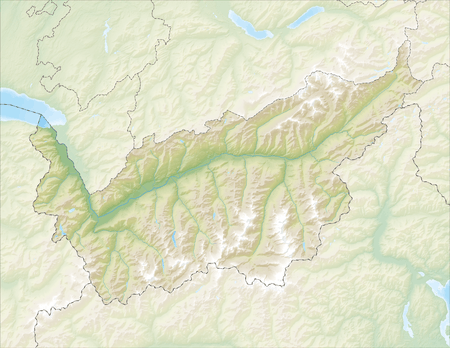Steg-Hohtenn
Steg-Hohtenn is a municipality in the district of Raron in the canton of Valais in Switzerland. The municipality comprises the villages of Steg and Hohtenn.
Steg-Hohtenn | |
|---|---|
 Coat of arms | |
Location of Steg-Hohtenn 
| |
 Steg-Hohtenn  Steg-Hohtenn | |
| Coordinates: 46°17′N 7°47′E | |
| Country | Switzerland |
| Canton | Valais |
| District | Raron |
| Government | |
| • Mayor | Philipp Schnyder |
| Area | |
| • Total | 14.21 km2 (5.49 sq mi) |
| Elevation | 660 m (2,170 ft) |
| Population (2018-12-31)[2] | |
| • Total | 1,592 |
| • Density | 110/km2 (290/sq mi) |
| Postal code | 3940 |
| SFOS number | 6204 |
| Surrounded by | Eischoll, Ferden, Gampel, Kippel, Raron, Turtmann, Unterbäch, Wiler (Lötschen) |
| Website | www SFSO statistics |
History
Steg-Hohtenn was created on 1 January 2009 through the merger of the former municipalities of Steg and Hohtenn.[3]
Geography
Steg-Hohtenn has an area, as of 2011, of 14.2 square kilometers (5.5 sq mi). Of this area, 10.1% is used for agricultural purposes, while 38.1% is forested. Of the rest of the land, 9.6% is settled (buildings or roads) and 42.1% is unproductive land.[4]
The village of Steg is located at the southern entrance to the Lötschental or Lötschen valley. The western border of the village is the Lonza river, which is also the district border and the border with the neighboring village of Gampel.
Hohtenn village is located on terrace above the eastern entrance to the Lötschental and is about 150 meters (490 ft) above Steg.
Demographics
Steg-Hohtenn is located in the German speaking section of the canton and consists of the villages of Steg (with about 1,300 inhabitants) and Hohtenn (with about 250 inhabitants).
Steg-Hohtenn has a population (as of December 2018) of 1,591.[5] As of 2008, 7.5% of the population are resident foreign nationals.[6] Over the last 10 years (2000–2010 ) the population has changed at a rate of -3.9%. It has changed at a rate of -0.3% due to migration and at a rate of -0.1% due to births and deaths.[4]
Most of the population (as of 2000) speaks German (95.8%) as their first language, Serbo-Croatian is the second most common (1.3%) and Albanian is the third (0.9%).[4]
As of 2008, the population was 50.6% male and 49.4% female. The population was made up of 705 Swiss men (46.6% of the population) and 61 (4.0%) non-Swiss men. There were 696 Swiss women (46.0%) and 52 (3.4%) non-Swiss women.[7]
As of 2000, children and teenagers (0–19 years old) make up 22.3% of the population, while adults (20–64 years old) make up 63.7% and seniors (over 64 years old) make up 14.1%.[4]
As of 2009, the construction rate of new housing units was 1.3 new units per 1000 residents.[4] The vacancy rate for the municipality, in 2010, was 0.13%.[4]
Economy
As of 2010, Steg-Hohtenn had an unemployment rate of 1.3%. As of 2008, there were 48 people employed in the primary economic sector and about 22 businesses involved in this sector. 461 people were employed in the secondary sector and there were 19 businesses in this sector. 482 people were employed in the tertiary sector, with 56 businesses in this sector.[4] There were residents of the municipality who were employed in some capacity.
Of the working population, 15.3% used public transportation to get to work, and 51.2% used a private car.[4]
Transport
Two railway stations are located within the municipality of Steg-Hohtenn. Gampel-Steg station is on the Simplon line from Lausanne to Brig, and is situated alongside the River Rhone at the villages lowest point. Hohtenn station is on the Lötschberg line from Bern to Brig, and is situated above Hohtenn village, some 450 metres (1,480 ft) higher than Gampel-Steg station.[8]
Hohtenn station is served by trains to Bern, Thun and Brig. Gampel-Steg station is served by trains to Brig, Visp, Martigny and Monthey. A PostAuto bus service links Gampel-Steg station, Gampel village and Hohtenn village.[8][9][10][11]
Notable residents
- Raphael Wicky retired international footballer
References
- "Arealstatistik Standard - Gemeinden nach 4 Hauptbereichen". Federal Statistical Office. Retrieved 13 January 2019.
- "Ständige Wohnbevölkerung nach Staatsangehörigkeitskategorie Geschlecht und Gemeinde; Provisorische Jahresergebnisse; 2018". Federal Statistical Office. 9 April 2019. Retrieved 11 April 2019.
- Amtliches Gemeindeverzeichnis der Schweiz published by the Swiss Federal Statistical Office (in German) accessed 14 January 2010
- Swiss Federal Statistical Office accessed 13-October-2011
- Swiss Federal Statistical Office - STAT-TAB, online database – Ständige und nichtständige Wohnbevölkerung nach institutionellen Gliederungen, Geburtsort und Staatsangehörigkeit (in German) accessed 23 September 2019
- Swiss Federal Statistical Office - Superweb database - Gemeinde Statistics 1981-2008 (in German) accessed 19 June 2010
- Ständige Wohnbevolkerung nach Geschlecht und Heimat am 31.12.2009.xls (in German and French) accessed 24 August 2011
- map.geo.admin.ch (Map). Swiss Confederation. Retrieved 16 October 2013.
- "Spiez–Lötschberg–Brig" (PDF). Bundesamt für Verkehr. Retrieved 14 October 2013.
- "Lausanne–Sion–Brig (RER Vaud,lignes S1,S3)" (PDF). Bundesamt für Verkehr. Retrieved 14 October 2013.
- "Gampel-Steg–Hohtenn–Goppenstein–Blatten (Lötschen)–Fafleralp" (PDF). Bundesamt für Verkehr. Retrieved 14 October 2013.
External links
| Wikimedia Commons has media related to Steg-Hohtenn. |
- Official website of the former municipality of Steg VS
- Benken (VS) in German, French and Italian in the online Historical Dictionary of Switzerland.
- Steg in German, French and Italian in the online Historical Dictionary of Switzerland.
- Hohtenn in German, French and Italian in the online Historical Dictionary of Switzerland.